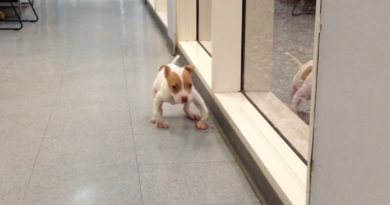A Primer on Canine Cancers
A lump, a limp, a loss of appetite. Notice one of these in your dog and your first thought is likely to be, “Huh. Wonder what’s causing that?” Your second thought may be, “Could it be cancer?” It’s a reasonable question, especially if your dog is middle-aged or older. According to the American Veterinary Medical Association (AVMA), one in four dogs will develop some form of cancer during their lifetimes.
What Is Cancer?
When cells begin replicating uncontrollably, the growth is called a neoplasm (literally, new growth), or tumor. A neoplasm can be either benign or malignant; only malignant neoplasms are considered cancers. As the AVMA notes on its website, “Benign neoplasms tend to grow slowly; displace, but do not tend to invade, the surrounding body tissues; and do not spread throughout the body. Malignant neoplasms, on the other hand, can be unpredictable and grow at various rates (sometimes rapidly); invade the tissues around them; and spread, or metastasize, to other parts of the body. The word tumor or mass is often used to describe the actual swelling or other physical appearance of a neoplasm.”
While we use the word as a singular, there are many types of cancers, categorized by the organs or systems they affect.
GET THE BARK NEWSLETTER IN YOUR INBOX!
Sign up and get the answers to your questions.
• Carcinoma: Begins in the skin or tissues that line or cover the internal organs.
• Sarcoma: Begins in bone, cartilage, fat, muscle, blood vessels, or other connective or supportive tissue.
• Leukemia: Begins in blood-forming tissue.
• Lymphoma: Begins in the cells of the immune system.
Terms: Grade, Stage
Grade describes the appearance of the cancerous cells, while stage describes a tumor’s size and how far it has spread from its point of origin.
A cancer metastasizes, or spreads, when cells break away from the main tumor and enter the bloodstream or lymphatic system, which carry fluids around the body—basically, the cells use these systems as highways to find new places to grow. While, theoretically, all cancers can metastasize, not all cancer cells have the capacity on their own to do so, or may lie dormant for months afterward moving away from their source.
Dogs tend to develop most cancers later in their lives, but some breeds are known to be at higher risk for specific types of cancers, like osteosarcoma, often at a younger age. A breed’s genetic vulnerability isn’t the only factor, however. Individual dogs of any breed (or mix) have higher or lower sensitivities that may affect whether or not they develop cancer, and how that cancer behaves.
Based on research in both humans and animals, we know that cancer is a complex process that can be triggered by hereditary, environmental and nutritional factors. In both people and animals, cancer development is a complex process that proceeds gradually through the interaction of multiple factors.
—Merck Veterinary Manual
What Are the Treatment Options?
How a canine cancer is treated depends on where it is, what system(s) it affects and how that particular cancer is known to respond to the various available options. Often, more than one approach is used. Barring the possibility of completely eliminating the cancer, veterinary specialists look for ways to put it into remission and/or help dogs and their owners cope with the challenges it creates.
Surgery tops the list of the most common strategies. Removal of a malignant tumor with complete margins—encased in healthy tissue—offers a hopeful prognosis. Surgery is also used to improve a dog’s quality of life. For example, in the case of leg-based bone cancer (appendicular osteosarcoma), amputation of the affected limb can significantly reduce the dog’s pain. While it isn’t necessarily a cure, it helps a dog be more comfortable. Surgery may be followed by chemotherapy and/or radiation, or they may be used on their own.
Chemotherapy uses drugs to kill or slow the growth of cancer cells, and may be used to treat a cancer that doesn’t lend itself to surgical intervention, or to reduce the size of a tumor before surgery is attempted. It’s also used to eliminate microscopic cancer cells before they can spread to other parts of the body. Unlike people, dogs rarely experience the side effects common to humans; 70 percent suffer few, if any, side effects.
Radiation therapy destroys tumor cells’ DNA and is most often used with solid tumors—carcinomas or sarcomas. The goal is to provide long-term control by shrinking tumors, and, possibly, a cure. Radiation is delivered as either external beam radiation therapy (also known as teletherapy) or stereotactic radiation therapy (SRT). SRT is particularly useful for brain and nasal cancers and can require only one to three treatments instead of the 15 to 20 needed for teletherapy. Other types of tumors, such as soft tissue sarcomas of the limbs, can be treated with repeated low doses of radiation, often resulting in a cure.
Another approach, cryosurgery—or more accurately, cryotherapy, since no cutting is involved—uses liquid nitrogen to freeze small skin and subcutaneous (under the skin) tumors; it reportedly has a very high success rate. Swelling, reddening, and occasionally pain and lameness are among the possible side effects. At the upper end of the temperature scale, hyperthermia uses heat to damage cancer cells, and is almost always paired with other forms of therapy rather than used as a standalone. On its own, it has few side effects.
Many of these approaches have been used for decades, and their limits and therapeutic potential are well known. However, in recent years, more options are being tested in vet school laboratories and clinics across the country. Among them, immunotherapy—a way of weaponizing a dog’s immune system to take action against a cancer by recognizing the danger and destroying the cancer cells—and genetic manipulation have had encouraging results.
For example, an experimental vaccine made from a dog’s individual tumor has been used to treat bone cancer. In a study at the University of Missouri, the treatment plan for dogs with osteosarcoma was amputation of the affected limb followed by a vaccine made from the dog’s tumor. According to Jeffrey Bryan, DVM, MS, PhD, DACVIM/Oncology, “It’s the first time that dogs with osteosarcoma have experienced prolonged survival without receiving chemotherapy, which is really exciting.”
Another recently developed approach involves sequencing a tumor’s DNA to identify cancer-causing mutations and then using a customized drug therapy to attack the cancer cells; the treatment is delivered in pill form and can be administered at home.
And on the horizon, metabolomics, the large-scale study of very small molecules. At the Cornell College of Veterinary Medicine, a study of a type of lymphoma common to both people and dogs began in mid-2020. To look for metabolic changes similar to those found in people with lymphoma, blood from healthy dogs is being analyzed and compared to samples from dogs who’ve been diagnosed with this cancer. According to a story in the Cornell Chronicle, “If the project is successful, it may one day allow oncologists to use a patient’s metabolic profile—as well as the DNA of the tumor—to design a precision medicine treatment plan. Genetic data shows what mutations a tumor has, but metabolomics reveal what is actually happening inside the cells.”
Cancer’s Warning Signs
Changes in a dog’s behavior or appearance, such as those listed here, might indicate the development of cancer. While these are not always signs of cancer, paying attention to such changes and bringing them to the attention of your veterinarian as soon as they occur increases the chances that a cancer will be detected and treated at an early stage.
- A growing or changing lump
- Swollen lymph nodes
- Sudden abdominal swelling
- Unexplained bleeding from the mouth, nose or genital area
- Difficulty breathing, chewing, swallowing, urinating or defecating
- Persistent sores or swelling
- Unexplained bad breath or other odor
- Dry cough
- Lowered stamina
- Recurrent vomiting or diarrhea
- Loss of weight or appetite
- Lack of interest in physical activities
- Indications of physical discomfort, such as lameness or stiffness
Who Manages Treatment?
Diagnosing and treating canine cancer may involve a three-part team: the dog’s general-practice veterinarian, a veterinary oncologist and, sometimes, a university teaching hospital. The initial diagnosis is most often made, or at least suggested, by the dog’s family veterinarian. Many vets will then refer their patient to a specialist to confirm the diagnosis and map out a treatment plan. Some of those specialists practice at university teaching hospitals, where the options and clinical capacities tend to be more extensive than at individual practices. Independent specialists may refer their patients to these facilities for treatment for the same reason.
What Are the Goals of Treatment?
The ideal and best-case scenario is to completely eliminate, or cure, the cancer. While this is sometimes possible, remission is usually a more realistic goal. Remission, or a regression of the cancer, can be partial—meaning that the disease’s burden on the body has been reduced by at least 50 percent—or complete—meaning that the cancer is undetectable by any standard screening test. Remission is rarely permanent, and dogs will usually experience a relapse at some point. If achieved, a second remission is likely to be shorter, since over time, cancer cells develop an immunity to the drugs used to fight them.
Cancers are wildly variable in their behaviors and responses to treatment; some, either because they’ve advanced too far or are too aggressive, are unlikely to go into remission. In that case, your veterinarian will treat your dog’s symptoms, including pain, with the goal of keeping him comfortable and maintaining his quality of life as long as possible.
What Are Clinical Trials and Why Should I Look for One?
Clinical trials—research studies aimed at evaluating a medical, surgical or behavioral intervention for a particular health problem—offer participants potential for a longer and better quality of life as well as an opportunity to help others (in this case, dogs) who may develop the same problem in the future.
Many are run by academic institutions; each has very specific criteria for participation; and they can go on for weeks, if not months. Depending on how they’re funded, they may be free or a fee may be required. It’s not always easy, or even possible, to find one within reasonable driving distance that would be a good fit for your dog’s cancer.
Regardless, once you have a diagnosis, it can be worth the effort to look for one that’s appropriate for your dog’s condition. The AVMA maintains a searchable animal health studies database, and the Veterinary Cancer Society has an accessible database that lists both universities and other organizations running trials. The Comparative Oncology Trials Consortium maintains a list of trials underway at vet schools across the nation. The nonprofit Morris Animal Foundation also provides a list of health studies that can be sorted by species and health issue.
Here’s an example that highlights the process. At the University of California, Davis, human oncologist Robert Canter and veterinary oncologist Michael Kent launched a clinical immunotherapy trial to test their theory that NK (natural killer) cells will attack tumor cells and stop them from creating new tumors. In June 2020, a chocolate Lab named Josie with oral melanoma who had been given two to four months to live was infused with NK cells from a healthy dog. While it’s too soon to tell if the theory will hold, six months later, Josie was back doing what she loved: retrieving ducks.
Cancer is a cellular glitch, an aberration, a system malfunction. Genetics may play a role and certainly, there are environmental stressors: tobacco smoke, chemicals associated with almost every aspect of everyday life and other things we probably aren’t even aware of yet. At any rate, very few cancers have a single known cause or restrict themselves to a single age, gender or breed type.
Statistics can be useful when considering various treatment options, but they don’t predict how an individual dog, or the cancer he’s dealing with, will respond to whatever approach is taken. Some cancers can be successfully treated, some can be put into remission for a time, and some are just too aggressive to overcome.
Whatever cancer challenge your dog may face, keep in mind that there are things you can do to improve the quality of his life and, ideally, extend it. Ask questions, listen carefully to the answers and make decisions based on what best serves your dog. Your veterinarian is your partner in figuring out how to compassionately go forward.





Some are medicines that help people when doctors prescribe. Best and news about drug.
new ed pills
What side effects can this medication cause? Definitive journal of drugs and therapeutics.
Medicament prescribing information. Read information now.
cialis vs viagra
Everything about medicine. Some trends of drugs.
Actual trends of drug. Some are medicines that help people when doctors prescribe.
buy generic viagra
drug information and news for professionals and consumers. Drugs information sheet.
Medscape Drugs & Diseases. drug information and news for professionals and consumers.
where to buy cheap propecia without a prescription
Commonly Used Drugs Charts. Medicament prescribing information.
dark web search engines deep web drug markets
legitimate online pharmacies https://pillswithoutprescription.pro/#
[url=http://trazodone.beauty/]trazodone 75 mg tablets[/url]
reliable mexican pharmacy – perscription drugs without perscription no perscription drugs canada
pharmacy canadian – list of safe online pharmacies canadian prescription prices
online canadian pharmaceutical companies: canadian online pharmacy for viagra best canadian online pharmacy reviews
dark web market links https://world-darkmarket-online.com/ dark web links
paxlovid pharmacy https://paxlovid.pro/# – paxlovid india
best ed pill https://edpills.ink/# – best ed pills online
cytotec online https://cytotec.ink/# – buy cytotec over the counter
amoxicillin 750 mg
what are ed drugs https://edpillsotc.store/# – online ed medications
paxlovid buy https://paxlovid.bid/ paxlovid generic
buy Kamagra https://kamagra.icu/# – buy kamagra online usa
buying prescription drugs in mexico online https://mexicanpharmacy.company/# mexican pharmaceuticals online mexicanpharmacy.company
amoxicillin discount coupon https://amoxicillin.best/ order amoxicillin online no prescription
price of doxycycline https://doxycycline.forum/ doxycycline 100 mg
I enjoy the efforts you have put in this, thanks for all the great posts.
buy cipro online https://ciprofloxacin.life/ ciprofloxacin generic price
I have not checked in here for some time as I thought it was getting boring, but the last several posts are great quality so I guess I will add you back to my daily bloglist. You deserve it my friend 🙂
Hey! This is my first visit to your blog! We are a collection of volunteers and starting a new initiative in a community in the same niche. Your blog provided us beneficial information to work on. You have done a marvellous job!
black internet darknet search engine onion market
Valuable info. Lucky me I found your web site by accident, and I’m shocked why this accident didn’t happened earlier! I bookmarked it.
As a Newbie, I am always searching online for articles that can aid me. Thank you
I do enjoy the manner in which you have presented this specific concern plus it really does supply us some fodder for consideration. Nonetheless, from just what I have observed, I basically hope when the actual feedback stack on that individuals stay on issue and not embark on a tirade involving the news du jour. All the same, thank you for this fantastic point and even though I can not really agree with it in totality, I respect your perspective.
Today, I went to the beach with my kids. I found a sea shell and gave it to my 4 year old daughter and said “You can hear the ocean if you put this to your ear.” She put the shell to her ear and screamed. There was a hermit crab inside and it pinched her ear. She never wants to go back! LoL I know this is entirely off topic but I had to tell someone!
You can definitely see your expertise within the work you write. The sector hopes for more passionate writers like you who aren’t afraid to say how they believe. Always follow your heart.
Hello, you used to write fantastic, but the last several posts have been kinda boringK I miss your super writings. Past few posts are just a bit out of track! come on!
Hi my friend! I want to say that this article is amazing, nice written and include approximately all important infos. I’d like to see more posts like this.
What Is Sugar Defender? Sugar Defender is a natural blood sugar support formula created by Tom Green. It is based on scientific breakthroughs and clinical studies.
Outstanding post, you have pointed out some good points, I likewise believe this s a very excellent website.
Having read this I thought it was very informative. I appreciate you taking the time and effort to put this article together. I once again find myself spending way to much time both reading and commenting. But so what, it was still worth it!
I’d perpetually want to be update on new blog posts on this website , saved to fav! .
I really like your blog.. very nice colors & theme. Did you design this website yourself or did you hire someone to do it for you? Plz answer back as I’m looking to design my own blog and would like to find out where u got this from. thank you
Greetings! I’ve been following your weblog for a while now and finally got the bravery to go ahead and give you a shout out from Porter Texas! Just wanted to say keep up the excellent work!
It’s actually a great and helpful piece of info. I am glad that you just shared this useful info with us. Please stay us informed like this. Thanks for sharing.
We stumbled over here different web address and thought I might as well check things out. I like what I see so now i am following you. Look forward to looking at your web page repeatedly.